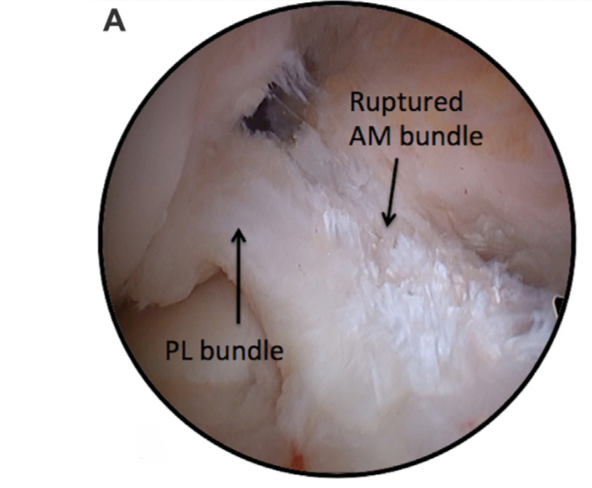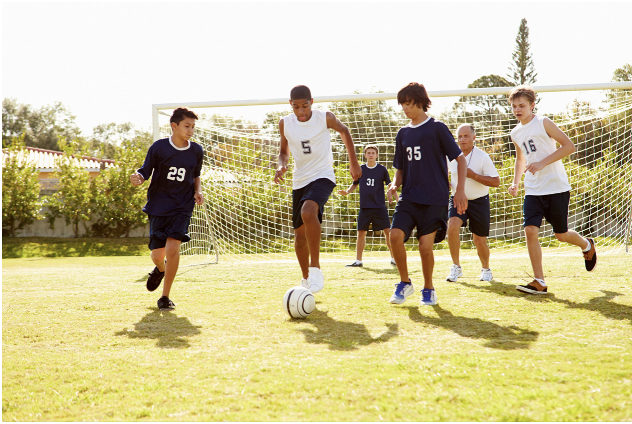Woman running with a knee injury. Is it possible for my partial ACL tear to heal without surgery?
Image by Izf from Canva.com
If you have suffered a partial ACL injury, you may be wondering what your options are. If your ACL will heal on its own or how long your recovery will be. With complete ACL tears, the recovery options and ACL rehabilitation timelines are well defined. You have a choice between either reconstruction surgery or non-surgical rehabilitation where the ligament is not repaired. With partial ACL tears the options are actually very similar and there are a number of reasons why a person may choose one or the other.
What is a partial ACL tear?
Ligament injuries can be classified into three “grades” of injury with grade 1 being the least severe and grade 3 being the most severe.
Grade 1: The ligament fibres stretch but do not tear [3]
- Mild swelling and pain
- No feelings of instability or knee giving out
- No laxity (excess joint movement) with a normal feeling of resistance when stretched (firm end-feel)
Grade 2: The ligament fibres are partially torn [3]
- Moderate swelling and pain
- Knee may feel unstable or give out during activity
- Some increased joint laxity but still a similar feeling of resistance when stretched (firm end-feel)
Grade 3: The ligament fibres have been completely torn [3]
- Limited pain and variable amounts of swelling initially, followed by delayed swelling due to joint bleeding 1-2 hours after injury (Haemarthrosis)
- Feelings of instability and giving out
- Significantly increased laxity with no feeling of resistance with ligament testing (empty end-feel)
If you have a complete or partially torn ACL use the Curovate App for structured rehabilitation devleoped by a physical therapist to recover.
A complete ACL tear would be classified as a grade 3 ligament injury. Partial tears of the ACL are not as well defined and there is a lot of variability in the severity and definition of a partial ACL tear.[6] For the purposes of this blog we will classify partial ACL injuries as grade 2 ligament injuries; however within that definition there may be people with ACLs that are almost completely torn and some with ACLs that are only slightly torn.
How common are partial ACL tears?
There is lots of research on the number of complete ACL tears each year. You can even calculate your risk of complete ACL tears by sport, level of play, and a number of other variables. In the US it is estimated that there are up to 250,000 ACL tears each year.[13] Determining the number of partial ACL injuries is more difficult due to variable definitions and difficulty in diagnosing a partial tear. That being said, we do know that partial ACL injuries are not very common. Research suggests that partial ACL tears make up anywhere from 5-28% of ACL injuries.[11,12] The variability in reporting may be for a number of reasons, such as differing definitions of a partial ACL tear and difficulty diagnosing the extent of the injury with partial tears.
Will a partial ACL tear heal on its own?
The short answer is that a partial tear of the ACL will not heal on its own. People often think that because the ligament is not completely torn it will heal on its own, but this is typically not the case. The ACL does not heal on its own because it does not have any blood supply to it.[2] For this reason recovery from an ACL tear is very similar to a complete ACL tear.

How do I recover from a partial ACL tear?
Before answering this question it is helpful if you know the typical recovery process for a complete ACL tear. A complete ACL tear can be treated either through an ACL reconstruction surgery or non-surgically.[7] Whether someone chooses to have their ACL reconstructed or not depends on many personal factors as well as factors related to the injury.[7] If the person wants to return to activities with jumping, cutting and pivoting, surgery is usually recommended, but if they just want to do straight line activities then non-surgical treatment is a good option also.[7] There is increasing evidence that non-surgical treatment may be an option, even for people that want to participate in sport. Even if a person wants to have surgery, a rehabilitation program of “prehabilitation” is recommended to improve their function and strength before surgery.[7] Another consideration is if there is damage to other structure in the knee as well as their ACL, such as a meniscus or medial collateral ligament (MCL), then surgery is often recommended.[7] Overall, the length of recovery from a complete ACL injury is approximately 9-12 months before returning to sports if you have a reconstruction surgery.[10] Recovery is shorter without surgery (approximately 3-6 months).[5]
Recovery from a partial ACL injury can also be done through surgery or non-surgical rehabilitation; however which is the best option is less clear as there is more variability with these injuries. If you want to return to sports and an active lifestyle, surgery may be the best option, as with a complete tear. This is because it is common for the remaining ACL to tear if it is not repaired, especially if participating in contact sports or sports with pivoting or people under the age of 20.[9][13] One study estimated that almost 40% of partial ACL tears will result in a complete tear in the future.[9][13] But with surgical reconstruction, there is also a risk of re-injury.[1]
For people with a partial tear that leads to a complete tear, 50% have a meniscus injury as well.[9] Injury to other knee structures such as the meniscus is a factor that may indicate that surgery is recommended in partial ACL tears, as in complete ACL tears.[7][12] If the partial tear also resulted in a bone bruise, there is an 80% chance of it progressing to a complete tear.[13] Typically the knee caves in and forward with an ACL and it is this motion of the knee that can scause a bone bruise on the thigh bone, called the femur, and or the shin bone, called the tibia. The presence of this bone bruise increases the chance of a future complete ACL tear. It is also important to consider that the risk of retearing a paritally torn ACL is also going to depend on the extent of the partial tear, meaning if the ACL is 75% torn it is more likely to tear than if it is only 25% torn.

Image by Monkey Business Images from Canva.com
Long term outcomes for a partially torn ACL
The long term outcomes do seem to be slightly better for partial ACL tears as people with partial ACL tears are less likely to have injury to other knee structures, less likely to need surgery, and are more likely to return to the same activities as before the injury than people with a complete ACL tear.[4][8]
The amount of laxity (excessive joint movement) after an ACL injury is also a factor. One study recommended that if there was less than 4 mm of increased forward movement of the lower leg on the thigh when testing the ACL, surgery was not recommended; but if it was greater than 4 mm then surgery was recommended.[12] This laxity is tested by a health care provider when they pull your shin forward and hold your thigh in place. This clinical test is called a Lackman's test or anterior drawer test for ACL laxity. There is a special machine that can actually measure the millimeters of movement and therefore the lacity of an ACL. If your knee has very little laxity and does not feel unstable when you move and do your day-to-day activities then non-surgical treatment may be a good option for you.[13]
There are multiple surgical approaches to repair a partially torn ACL, but there is debate over which approach is best.[12] The traditional surgical approach for a partial ACL tear is an ACL reconstruction surgery, as in a complete tear. ACL reconstruction surgery requires the remaining ACL to be cut before reconnecting the entire ligament using a graft, which is a piece of tissue from another part of the body. Your surgeon may recommend you try non-surgical rehabilitation and then come back if you end up with a complete tear of the ACL in the future. The recovery time for a partial ACL tear is similar to that of a complete tear, both for surgical and non-surgical treatment options.
Conclusion
If you have a partial ACL tear, it is unlikely that it will heal on its own. ACL surgery and non-surgical rehab are both reasonable options. There are a number of factors that influence if surgery is indicated such as the amount of knee instability and excess movement, the extent of the tear, if there is a bone bruise, and what activities you want to participate in going forward. The risk of not having a partial tear surgically repaired is that it may lead to a full tear in the future; however, surgery usually requires the ligament to be fully torn anyway. In summary, when deciding how to recover from a partial ACL injury, you must consider both the extent of your injury and your desired activity levels in the future.
Regardless of the extent of your injury and if you have surgery, a progressive rehab program is essential for getting you back to what you love to do and preventing further injury or re-injury. The Curovate mobile app has surgical and non-surgical ACL rehab programs that can guide your rehab and get you back to normal. If you are interested in non-surgical rehabilitation with a structured program developed by a physical therapist download Curovate from the links below and select the ACL non-surgical option in our app. If you need further customized assistance during your ACL recovery check out our Virtual Physical Therapy page to book your 1-on-1 video session with a physical therapist.
 |
 |
|---|
Other Blogs Related to ACL Injury
- Am I at risk of tearing my ACL? How can I prevent an ACL injury? How can I avoid a reinjury to my ACL?
- What is an ACL and How is It Injured?
- Why Should I Exercise before My ACL Surgery- the Importance of ACL Prehabilitation
- I injured my ACL, what should I do?
- Why female soccer players suffer more ACL injuries
- Turf leads to more ACL injuries - fact or fiction?
- How to prevent ACL injuries
- When can I return to sport after an ACL injury or surgery?
- After I wake up from ACL surgery, what should I expect?
- What does my ACL recovery timeline look like?
- Is ACL surgery painful?
- Where is my new ACL coming from? What are the most common areas for an ACL graft?
- Can an ACL injury lead to arthritis in the future?
- Did I retear my ACL graft?
- Is my ACL graft weaker than my original ACL? Or is my ACL graft stronger than my original ACL?
- What does the research say about non-operative ACL rehabilitation?
References
1. Acl rehabilitation: Re-injury and return to sport tests. Physiopedia. (n.d.).
2. Anterior Cruciate Ligament (ACL) Injuries | Michigan Medicine. (n.d.).
3. Anterior cruciate Ligament (ACL) Injury. Physiopedia. (n.d.).







